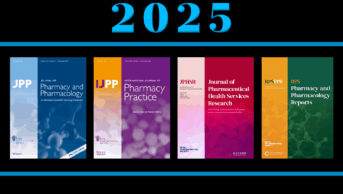
Shutterstock.com
Involving patients and carers in research around their own services is nothing new. This kind of work has been around for decades, but people often come away from these patient and public involvement and engagement (PPIE) experiences with little more than compensation and a cheese and pickle sandwich. So, are we truly co-producing research-led pharmacy services, or are we simply paying lip service to PPIE?
As a team of researchers and participants (based at Leeds Teaching Hospitals NHS Trust), we know PPIE has its benefits. It ensures our research resonates with the needs of real people and makes sure our outcomes can be translated into practice. Our patient participant Andrew Taylor — who previously shared his experiences of healthcare in The Pharmaceutical Journal — is one of the patients whose voice is being heard. Working alongside healthcare researchers has given him confidence, connected him with likeminded people and offered him a way to give back to the NHS he is so grateful for. He feels he has a purpose and is proud to know his experiences will improve services for generations to come.
The benefits of this way of working aren’t just for patients. As pharmacists, we feel PPIE has transformed our personal and professional practice. Our perspective has been changed now we have the space and time to truly consider the patient’s lived experience. As a result of this work, we are now truly focused on what matters most to patients. But as busy pharmacy professionals, many of us don’t make the time for PPIE. So, we challenge everyone to consider how they could include this approach in their everyday pharmacy activities.
You could seek patient feedback through annual satisfaction surveys, but this is just the start. Taking that next step beyond a survey or patient-completed questionnaire towards fully engaging PPIE is an opportunity we believe all patients and carers should be offered.
Every PPIE panel should truly represent the wider population being served to ensure that the voices of minority groups are heard. Any research or service changes must positively affect their needs, as well as the needs of the majority. Recruiting and coordinating a panel of PPIE participants takes time and effort; considering this, it seems wasteful to involve the panel only in a tokenistic way — in a ‘tick box’ fashion, or by disregarding nuggets of patient wisdom that challenge our preconceived ideals.
Andrew has taken part in several PPIE projects and is always surprised at just how different each could be. Not in subject matter, but in the way facilitators engaged their PPIE participants: he did not always feel engaged. We need to do better, and we accept that some of these challenges are related to the facilitation. But Andrew also suggested that some attendees appear to have an axe to grind, and one that is not always relevant to the subject at hand, which can take up valuable time.
Working closely with the same diverse group of PPIE members over time helps to build rapport that is rewarding for both parties. The patient gains the confidence to speak up, and the trust that anything said is confidential or anonymised. In turn, the facilitator gains a unique insight into the use and improvement of a service.
Poor relationships, on the other hand, can lead to conversation breakdown, which can cause patients to close up. Once, Andrew made a point that was quickly brushed off, leaving him feeling foolish in front of the other group members. A seed of doubt discouraged him from sharing further experiences with the team, for fear of embarrassment.
Thankfully, not every study looks like this. Like some others across the UK, our research team are pushing the limits of involvement; this includes patients attending all meetings; giving patients the responsibility of designing what they would want to see and read in a poster, letter or leaflet; setting up workshops so patients can be involved in data analysis; and even co-writing papers with patients to make sure their voice is carried through from start to finish.
If facilitated well, this forum allows us to work together to turn patients’ lived experiences into real and meaningful change. This is important work, and we should not be put off by the challenges; we must represent all our patients.
Starting the journey to fully involving your patients can be daunting, but start small. Build confidence by talking openly with patients about pharmacy services and their experiences.
Keep an open mind, and remember there is plenty of support available to you (see Box).
Box: Valuable resources on involving patients in research
Setting up
- Video by the University of Bradford on finding the right people for patient and public engagement: https://www.youtube.com/watch?v=_wBvA9SMdxY
- Resources from Involve, a UK charity for patient participation: https://www.involve.org.uk/resources/knowledge-base
- Tomlinson J, Medlinskiene K , Cheong VL et al. Patient and public involvement in designing and conducting doctoral research: the whys and the hows. Res Involv Engagem 2019;5(23). doi: 10.1186/s40900-019-0155-1
- Toolkit from the Centre for BME Health for involving people from black, Asian and minority ethnic backgrounds: https://centreforbmehealth.org.uk/resources/toolkits/
Working with older people
- Davies K, Collerton JC, Jagger C et al. Engaging the oldest old in research: lessons from the Newcastle 85+ study. BMC Geriatr 2010;64(10). doi: 10.1186/1471-2318-10-64
- Cherubini A, Gasperini B. How to increase the participation of older subjects in research: good practices and more evidence are needed!, Age and Ageing, 2017;46(6):878–881. doi: 10.1093/ageing/afx123
- Shepherd V, Hood K, Sheehan M et al. ‘It’s a tough decision’: a qualitative study of proxy decision-making for research involving adults who lack capacity to consent in UK. Age and Ageing 2019;48(6):903–909. doi: 10.1093/ageing/afz115
- Baldwin JN, Napier S, Neville S, Wright-St Clair VA. Impacts of older people’s patient and public involvement in health and social care research: a systematic review. Age and Ageing 2018;46(6):801–809. doi: 10.1093/ageing/afy092
- Field B, Mountain G, Burgess J et al. Recruiting hard to reach populations to studies: breaking the silence: an example from a study that recruited people with dementia. BMJ Open 2019;9:e030829. doi: 10.1136/bmjopen-2019-030829
The patient’s experience
- Hanson F & Hanson R. Reflections from a patient and carer on involvement in research and integrating care in the health system. International Journal of Integrated Care 2017;17(2):16. doi: 10.5334/ijic.3088
Making public involvement in research meaningful
- Massey K. Not just a ‘tick box exercise’ — meaningful public involvement in research. Int J Pharm Pract 2018;26:197–198. doi: 10.1111/ijpp.12450
- Locock L, Kirkpatrick S, Brading L et al. Involving service users in the qualitative analysis of patient narratives to support healthcare quality improvement. Res Involv Engagem 2019(5):1. doi: 10.1186/s40900-018-0133-z
Angela Burgin, advanced clinical pharmacist for ePrescribing, Medicines Management and Pharmacy Services, Leeds Teaching Hospitals NHS Trust
Heather Smith, consultant pharmacist for older people, NHS Leeds CCG embedded in Leeds GP Confederation
Justine Tomlinson, lecturer in physician associate studies and pharmacy practice, School of Pharmacy and Medical Sciences, University of Bradford
Andrew Taylor, expert patient partner, Bradford, West Yorkshire


